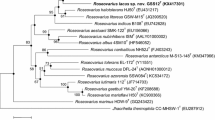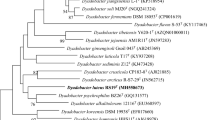Abstract
Microbiological analysis of samples of sedimentary rocks from various eras of the geological history of the Baikal rift has enabled us to isolate a large number of microorganisms that can be classified into new, previously undescribed species. The present work deals with the identification and study of the morphological, biochemical, and physiological properties of one such strain, Che 82, isolated from sample C-29 of 3.4–3.5 Maold sedimentary rocks taken at a drilling depth of 146.74 m. As a result of our investigations, strain Che 82 is described as a new bacterial species, Roseomonas baikalica sp. nov., belonging to the genus Roseomonas within the family Methylobacteriaceae, class Alphaproteobacteria.
Similar content being viewed by others
References
Torok, T., Hunter-Chevera, J., Repin, V.E., and Geletii, V.F., Preliminary Estimate of Microbial Diversity in the Water Samples and Sediments of Lake Baikal, Otsenka sponsiruemykh biologicheskikh issledovanii v Rossii dlya novogo tysyacheletiya (Evaluation of the Sponsored Biological Research in Russia for the New Millennium), Novosibirsk, 1999, vol. 2.
Andreeva, I.S., Ryabchikova, EI., Pechurkina, N.I., Zaitsev, B.N., Geletii, V.F., Korobushkina, E.D., Vinogradova, T.P., Torok, T., Hunter-Tsevera, J., and Repin, V.E., Morphological Analysis of Aerobic Microorganisms in the Deep Drilling Core (Lake Baikal), Geologiya i geofizika, 2001, vol. 42, nos. 1–2, pp. 220–230.
Repin, V.E., Torok, E., and Kuz’min, M.I., Microbial Biodiversity in Deep Sediments of Lake Baikal, Geologiya i geofizika, 2001, vol. 42, nos. 1–2, pp. 231–234.
Colwell, F.S., Stormberg, G.J., Phelps, T.J., Birnbaum, S.A., McKinley, J., Rawson, S.A., Veverka, C., Goodwin, S., Long, P.E., Russell, B.F., Garland, T., Thompson, D., Skinner, P., and Grover, S., Innovative Techniques for Collection of Saturated and Unsaturated Subsurface Basalts and Sediments for Microbiological Characterization, J. Microbiol. Meth., 1992, no. 15, pp. 279–292.
Manual of Methods for General Bacteriology, Gerhardt, P. et al., Eds., Washington: Amer. Soc. Microbiol., 1981 [Russ. Transl., Moscow: Mir. 1983–1984].
Bergey’s Manual of Systematic Bacteriology, 8th ed., vol. 1–2, Holt, J.G., Ed, Baltimore-London: Williams and Wilkins, 1986.
Marmur J., A Procedure for Isolation of Deoxyribonucleic Acid from Micro-Organisms, J. Mol. Biol., 1961, vol. 3, pp. 208–214.
Chomczynski, P. and Sacchi, N., Single-Step Method of RNA Isolation by Acid Guanidinium Thiocyanate-Phenol-Chloroform Extraction, Anal. Biochem., 1987, vol. 162, no. 1, pp. 156–159.
Kumar, S., Tamura, K., and Nei, M., MEGA3: Integrated Software for Molecular Evolutionary Genetics Analysis and Sequence Alignment, Brief Bioinform, 2004, vol. 5, no. 2, pp. 150–163.
Osterhout, G.J., Shull, V.H., and Dick, J.D., Identification of Clinical Isolates of Gram-Negative Nonfermentative Bacteria by An Automated Cellular Fatty Acid Identification System, J. Clin. Microbiol., 1991, vol. 29, no. 9, pp. 1822–1830.
Bibashi, E., Sofianou, D., Kontopoulou, K., Mitsopulos, E., and Kokolina, E., Peritonitis Due to Roseomonas fauriae in a Patient Undergoing Continuous Ambulatory Peritoneal Dialysis, J. Clin. Microbiol., 2000, vol. 38, no. 1, pp. 456–457.
Rihs, J.D., Brenner, D.J., Weaver, R.E., Steigerwalt, A.G., Hollis, D.G., Yu, V.L., Roseomonas, a New Genus Associated with Bacteremia and Other Human Infections, J. Clin. Microbiol., 1993, vol. 31, no. 12, pp. 3275–3283.
Lewis, L., Stock, F., Williams, D., Weir, S., and Gill, V.J., Infections with Roseomonas gilardii and Review of Characteristics Used for Biochemical Identification and Molecular Typing, Am. J. Clin. Pathol., 1997, vol. 108, no. 2, pp. 210–216.
Woese, C.R., Bacterial evolution, Microbiol. Rev., 1987, vol. 51, no. 2, pp. 221–271.
Rogers, S.O. and Bendich, A.J., Extraction of DNA from milligram amounts of fresh, herbarium and mummified plant tissues, Plant Molecular Biology, 1985, no. 5, pp. 69–76.
Bel’kova, N.L., Denisova, L.Ya., Manakova, E.N., Zaichikov, E.F., and Grachev, M.A., Species Diversity of Deep-Water Microorganisms of Lake Baikal: Analysis of 16S rRNA Sequences, Dokl. Akad. Nauk, 1996, vol. 348, no. 5, pp. 692–695 [Doklady Biol. Sci. (Engl. Transl), vol. 348, pp. 302–305]
Belikov, S.I., Grachev, M.A., Zemskaya, T.I. Manakova E.N., and Parfenova V.V., Determination of the Taxonomic Position of Bacteria from Lake Baikal by Sequencing 16S rRNA Fragments, Mikrobiologiya, 1996, vol. 65, no. 6, pp. 855–864 [Microbiology (Engl. Transl.), vol. 65, no. 6, pp. 746–754].
Amann, R.I., Shleifer, K.-H., and Ludwig, W., Phylogenetic identification and in situ detection of individual microbial cells without cultivation, Microbiol. Rev., 1995, no. 59, pp. 143–169.
Cheng-Ying, Jiang., Xin, Dai., Bao-Jun, Wang., Yu-Guang, Zhou., and Shuang-Jiang, Liu., Roseomonas lacus sp. nov., Isolated from Freshwater Lake Sediment, Int. J. Syst. Evol. Microbiol, 2006, no. 56, pp. 25–28.
Koneman, E.W., Allen, S.D., Janda, W.M., Schreckenberger, P.C., and Winn, W.C. Jr., Color atlas and textbook of diagnostic microbiology, 5th ed., 1997, Lippincott: Philadelphia, pp. 275–276.
Andreeva, I.S., Pechurkina, N.I., Ryabchikova, E.I., Belikov, S.I., Denikina, N.I., Puchkova, L.I., Emelyanova, E.K., Torok, T., Repin, V.E., A New Species of Cultitable Microorganism “Roseomonas baikalika” sp. nov. Found in Ancient SedImentary Rocks of Lake Baikal // Abstr. Int. Conf. “Microbial diversity: Current Situation, Conservation Strategy and Biotechnological Potentialities ICOMID 2005,” 20–25 Sept. 2005, Perm-Kazan-Perm, Russia, pp. 128–129.
Author information
Authors and Affiliations
Corresponding author
Additional information
Original Russian Text © I.S. Andreeva, N.I. Pechurkina, O.V. Morozova, E.I. Ryabchikova, S.I. Belikov, L.I. Puchkova, E.K. Emel’yanova, T. Torok, V.E. Repin, 2007, published in Mikrobiologiya, 2007, Vol. 76, No. 4, pp. 552–559.
Rights and permissions
About this article
Cite this article
Andreeva, I.S., Pechurkina, N.I., Morozova, O.V. et al. The new eubacterium Roseomonas baikalica sp. nov. isolated from core samples collected by deep-hole drilling of the bottom of Lake Baikal. Microbiology 76, 487–493 (2007). https://doi.org/10.1134/S0026261707040157
Received:
Issue Date:
DOI: https://doi.org/10.1134/S0026261707040157




